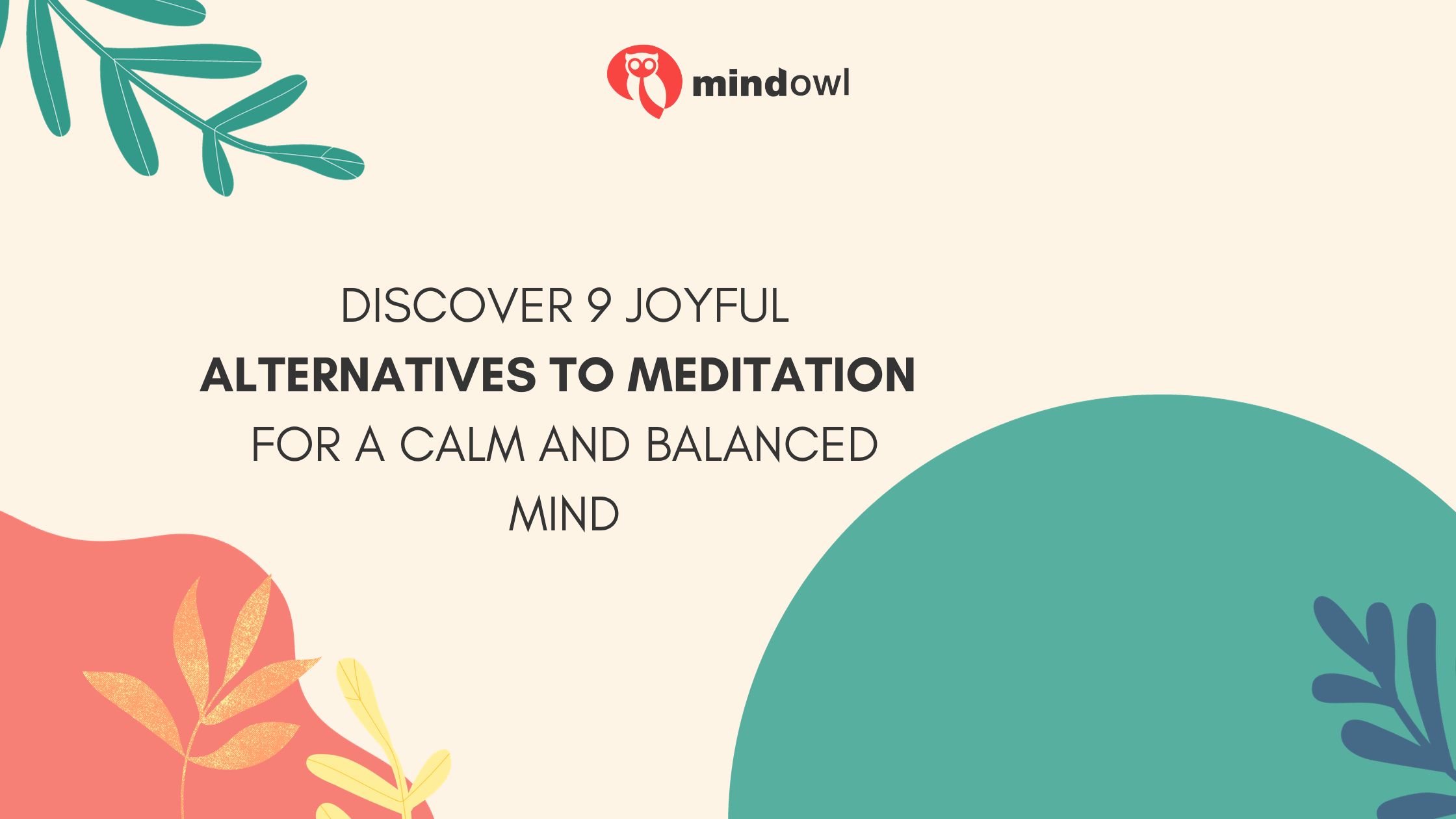Finding inner peace and a sense of equilibrium doesn’t always require sitting in silence with closed eyes. Meditation has long been revered for its mental health benefits, but let’s face it—not everyone can get into the lotus position and quiet their mind with ease.
Some find the stillness elusive or need to engage differently to attain that meditative bliss. Luckily, serenity isn’t exclusive to classic meditation; there are myriad joyful paths leading toward a calm and balanced mind.
In this blog post, we’re excited to share seven refreshing alternatives that might just become your new go-to methods for stress relief and mindful living. Ready to discover them? Let’s dive right in!
Key Takeaways
- You don’t need to sit still to find peace; breathwork, yoga, and tai chi use movement for calmness.
- Being in nature can lower stress and make you happy. Try mindful walking or touching the earth.
- Creative things like colouring, drawing, or drumming are fun ways to be present and relax your mind.
Reasons to Explore Alternatives to Meditation
Difficulty sitting still
Many people find they can’t sit still when they try to meditate. They may feel restless or impatient. You might wiggle, shift in your seat, or just get up after a few minutes. This is normal for lots of us! Sitting without moving isn’t easy if you’re not used to it.
Other ways can train the mind and move the body at the same time. These methods ease stress and anxiety too. Moving while being mindful helps focus thoughts and feelings. It offers an active way to achieve calmness instead of just sitting down.
Need for external focus
If you find sitting in silence challenging, seeking an alternative to meditation that engages the senses might be the key. Some people need something to do or see to keep their minds from wandering.
They may find activities that require them to focus on external factors more soothing. For instance, focusing on your breath during breathing exercises helps direct attention away from negative thoughts and promotes a sense of calm.
Or you could try walking meditation where paying attention to each step keeps you anchored in the present moment, reducing stress effectively.
Turning your gaze outwards can also decrease stress by keeping busy hands and eyes occupied with tasks like colouring or drawing. Research shows these creative outlets quieten the mind similarly to traditional forms of meditation while offering an enjoyable escape.
Your brain becomes aware of colours and shapes instead of internal chatter, which soothes anxiety and depression just like formal meditation practices do.
Desire for a joyful sense of calm
Finding peace and happiness inside ourselves can be a joyful journey. Many people turn to meditation alternatives to help them feel calm and joyful without sitting still for long periods.
These fun options tap into the aesthetics of joy, lifting spirits while easing the mind. Breathwork, active meditations like tai chi or yoga, and being in nature offer sensations that engage the body and boost your mood.
They allow you to focus on movements or the beauty around you, leading to a calm mind.
You don’t need to close your eyes and sit quietly to reach a state of blissful tranquility; simply engaging deeply with uplifting activities can serve as powerful forms of meditation.
Journaling helps release negative emotions while colouring provides an opportunity to practice mindfulness through creativity. Embracing these practices gives us fresh ways to achieve the same goal as regular meditation: reducing stress, enhancing physical and mental health, and inviting peace into our lives.
Breathwork as a Meditation Alternative
Breathwork offers a fantastic way to calm your mind without having to sit still for a long time. It uses the rhythm of our breath to bring peace and joy. Deep breathing exercises can reduce stress by shifting the body’s response to tension.
People find breathwork refreshing because it engages the body differently than seated meditation. It also requires focus on the sensations happening right now.
Using techniques like 4-7-8 breathing or box breathing, you train your attention on each inhale and exhale. This practice can create lasting changes in how well you concentrate throughout the day.
Breathwork has shown to help lower cortisol levels, which are often linked with chronic stress. As an added benefit, it boosts lung strength and helps maintain physical health benefits similar to those gained from daily meditation practices.
Incorporating Movement with Yoga and Tai Chi
Yoga combines physical postures with breathing techniques and meditation. It helps people focus on the present moment and feel more grounded. This form of meditation is great for those who find it hard to sit still.
You move through different poses that challenge your balance and flexibility, all while paying careful attention to your breath.
Tai Chi involves slow, graceful movements that flow together. It’s like a meditating dance, which can bring peace of mind and relieve stress. Practicing Tai Chi makes you aware of your body in space and improves posture.
Both yoga and Tai Chi offer physical benefits too, such as increased strength and better balance. They are moving meditations that keep both the body active and the mind calm.
Connecting with Nature through Walking and Forest Bathing
Connecting with nature through walking and forest bathing can provide a calming and grounding experience, allowing for mindfulness in a natural setting. It involves using mindful walking techniques, grounding practices, and embracing the numerous benefits of being in nature for overall mental and physical wellbeing.
Mindful walking
- Choose a quiet spot in nature for your walk, where you can really connect with your surroundings.
- Start by standing still and taking a few deep breaths to become aware of the moment.
- Focus on your senses. Listen to the birds, feel the breeze, and look at the colours around you.
- Walk slowly. With each step, notice how your feet feel as they touch the ground.
- Use grounding techniques. Imagine roots growing from your feet into the earth with every step you take.
- Acknowledge distractions but gently bring your focus back to the walk and your breathing.
- Take time to stop and look at interesting things you find along your path, like a leaf or a small insect.
- If thoughts come up about anything else like work or chores, just notice them and then concentrate again on walking.
Grounding techniques
Grounding techniques help you connect with the earth and bring your focus to the present moment. These practices can lower levels of cortisol, reducing stress.
- Walk barefoot on grass or soil. Feel the textures and temperatures under your feet.
- Lay down in a park or garden. Let your body touch the ground.
- Stand in a stream or paddle at the beach. Notice the water’s flow around your ankles.
- Hold rocks or soil in your hands. Explore their weight and surface.
- Hug a tree firmly. Sense its bark against your palms and face.
- Breathe deeply while sitting on the ground. Pay attention to each inhalation and exhalation.
- Slowly walk through a forest or woods. Absorb the sights, sounds, and smells around you.

Benefits of being in nature
Spending time in nature offers a multitude of benefits for our physical and mental well-being. Research supports the positive impact of being in green environments, showing that it can ease stress, enhance mood, and promote feelings of happiness and overall well-being.
Additionally, connecting with nature has been found to lower the body’s stress response, leading to reduced anxiety levels and a greater sense of relaxation. Furthermore, forest bathing specifically has been shown to have immune-boosting effects, lower high blood pressure, and contribute to quicker recovery from illness by engaging all senses.
Furthermore, spending time in natural surroundings can help restore energy levels while promoting clear thinking and reducing worry. The act of immersing oneself in nature allows for a sense of peace and connection with the environment which contributes to an increased feeling of vitality.

Other Creative Activities for Mindfulness
Journaling
Journaling is a powerful mindfulness activity that enhances self-awareness and resilience. Scientific studies have proven its ability to reduce stress, promote motivation, and improve overall health and wellbeing.
By practicing journaling, individuals can gain a deeper understanding of their thoughts and feelings, leading to improved emotional regulation and mental clarity.
Engaging in journaling allows individuals to develop a better sense of self-awareness while promoting resilience and well-being. This mindful practice has been scientifically proven to enhance mental clarity, improve emotional regulation, reduce stress levels, and boost overall well-being.
Colouring
Adult coloring is a proven mindfulness exercise that can relax the brain and induce a meditative state. It reduces thoughts, brings the focus to the present moment, and helps improve overall wellness.
Mindful coloring is considered an art form that aids in practising mindfulness through creativity, making it an enjoyable alternative to traditional meditation techniques. Colouring for adults has been found to relax the fear centre of the brain, allowing individuals to achieve a similar state as when meditating.
Drawing
Transitioning from the calming activity of colouring, mindful drawing offers a creative way to embrace mindfulness. Embracing experimentation and using simple shapes can help anyone create art, regardless of their artistic abilities.
This easy mindfulness activity can be a step up from colouring and provides an opportunity for personal expression in a relaxing manner.
Drumming
Drumming is a powerful way to enhance wellness and healing. It supports brain activity and physical coordination, relieving stress and improving fitness. As a calming tool, drumming complements meditation and mindfulness activities, offering a joyful alternative for achieving a balanced mind.
Playing the drums can be both mentally challenging and physically beneficial. It not only provides an avenue for creativity but also serves as a form of relaxation. Ultimately, drumming offers a unique approach to achieving mindfulness and calmness in daily life while engaging in an enjoyable activity that promotes overall well-being.
Cloud gazing
Cloud gazing is an informal form of meditation that involves calmly observing the shapes, movements, and patterns of clouds in the sky.
It provides an opportunity to practise mindfulness while appreciating nature’s beauty, helping to quiet a busy mind and bring about a sense of calm and tranquillity.
Engaging in cloud gazing aligns with the idea that connecting with nature can be restorative. A study suggests that sky views can have a positive impact on mental well-being by offering respite from stress and mental fatigue.
Morning pages
Morning pages involve writing three pages of longhand, stream of consciousness first thing in the morning. This practice can lead to a clearer mind, better ideas, and less anxiety.
It may be frustrating at times, but it can also be motivating and inspiring. Morning pages have been shown to significantly impact creativity, focus, and happiness. It is considered a meditative practice meant to clear the mind of white noise and induce creativity.

Conclusion
In conclusion, numerous joyful alternatives to meditation can promote a calm and balanced mind. Breathwork, yoga, tai chi, nature walking, creative activities like journaling and drumming, as well as practising gratitude and positive affirmations offer effective ways to achieve mindfulness.
These techniques cater to individuals who struggle with traditional meditation but desire its benefits. By exploring these diverse options, one can find the perfect practice that resonates with their unique preferences and lifestyle for a peaceful state of mind. For those exploring natural supplements to complement these practices, Nuzena Ashwagandha Pure+ Reviews offers insightful details on how ashwagandha can support stress relief, enhance mental clarity, and reduce fatigue, aligning well with holistic wellness strategies.
FAQs
1. What are some alternatives to trying to meditate to reduce stress?
Instead of traditional meditation, you can use an adult colouring book, take a walk in nature, or listen to music to bring the focus back and reduce stress.
2. Can attention to the present moment be achieved without practising meditation?
Yes, activities like art of living by Sri Sri Ravi Shankar teach focusing on whatever is happening right now, which is similar to the attention mindfulness involves during meditation.
3. Is it possible that colouring could help achieve a state like meditating?
Indeed, the act of colouring keeps your mind on the task at hand just as transcendental meditation does and helps prevent mind wandering.
4. How long should I practice these alternative methods each day?
You may find it easier starting with short sessions and then maybe working up to 60 minutes per day if you enjoy it and have time.
5. Will these alternatives help me if I believe meditation isn’t for me but still want a calm mind?
Certainly! If the traditional practice of meditation doesn’t suit you, trying alternatives can equally contribute towards achieving a calm and balanced mindset.
6. Do these activities work for those who suffer from depression and anxiety-like mediation does?
These mindful practices have been known to help many people manage symptoms associated with depression and anxiety similarly to how regular meditators benefit from their practice.
MindOwl Founder – My own struggles in life have led me to this path of understanding the human condition. I graduated with a bachelor’s degree in philosophy before completing a master’s degree in psychology at Regent’s University London. I then completed a postgraduate diploma in philosophical counselling before being trained in ACT (Acceptance and commitment therapy).
I’ve spent the last eight years studying the encounter of meditative practices with modern psychology.

